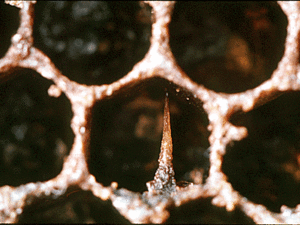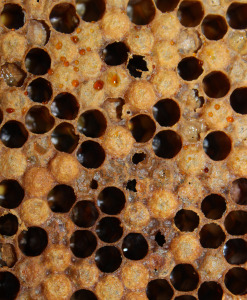American Foulbrood
Paenibacillus larvae ssp. larvae
THIS IS A REPORTABLE DISEASE IN TEXAS. Please contact TAIS at tais@ag.tamu.edu or (979) 845-9713 at first suspicion of American Foulbrood.
Useful Resources:
Description
While no longer the primary cause of honey bee death in the United States, American Foulbrood (AFB) remains a major threat to Apis mellifera worldwide. This disease is highly contagious and lethal in nature and is caused by a spore-forming bacteria. These spores can persist indefinitely, despite use of antibiotics. It is these characteristics that make American Foulbrood such a serious problem for beekeepers and is what prompted Texas and many other states to create apiary inspection programs in an attempt to safeguard the industry.
Etiology
The causative agent of American Foulbrood is Paenibacillus larvae, a gram-positive, spore-forming bacterium. While adult honey bees are carriers of the disease, they are not killed by AFB.
This disease affects primarily the pre-pupae and pupal stages of honey bee development. Spores, fed by nurse bees to larvae less than 53 hours old, germinate approximately 1 day after ingestion. After germination, the bacteria multiply in the midgut, eventually rupturing the gut wall and invade the body cavity, killing its host.
Larvae typically die in the upright position, unlike larvae affected by European Foulbrood, and may be capped over, therefore not visible. The brood pattern will often be scattered and the cappings will appear sunken and punctured. Once dead, the larvae will no longer be pearly white in color, but will turn from brown to black. The larvae will slowly desiccate and will shrink down onto the bottom of the cell.
One characteristic of AFB is the “ropy” condition of the infected bee that can be tested by inserting a twig or match into the affected cell, swirling the larvae around and drawing the dissolved larvae out of the cell. The dead larvae will adhere to the cell and can be stretched to at least 2 cm. After a month, the desiccating larvae will dry out completely, leaving a brittle, black scale attached to the bottom of the cell that is difficult to remove.

Pupal tongue (https://agdev.anr.udel.edu)
If the larva has reached the pupal stage before dying, it may leave behind a characteristic “pupal tongue” which protrudes from the dead pupae to the top of the cell. AFB also gives off a characteristic sulfur-like foul smell for which the disease gets its name “foulbrood”.
Spread and Control
American Foulbrood is spread from infected colonies to healthy ones via robbing and drifting bees. When a diseased colony inevitably dies, robbers from surrounding colonies rob the boxes of their AFB tainted honey and nectar, transmitting the bacteria to healthy hives. Beekeepers are also vectors of this disease. Care should be taken when interchanging frames between colonies, ensuring that no AFB is present. The same care should be taken when feeding honey or pollen. It also possible for AFB to be spread through package bees, but is less likely. If a hive is suspected to have AFB, any equipment (hive tool, smoker, bee suit, etc.) should be sterilized immediately before manipulating other honey bee colonies.
Antibiotics can be used prophylactically and to kill the active form of AFB. However, use of antibiotics after a colony is diagnosed with AFB will not kill the spores. Spores can lie dormant for decades and still have the potential to re-infect the colony when conditions are favorable. Generally, the most effective method to prevent the spread of AFB is to seal off and then burn all infected colonies and equipment, including adult bees, brood, wax, honey, frames, inner covers, and bottom boards. Hive bodies can be scraped clean and scorched, however there is no guarantee that all spores will be destroyed using this method.



